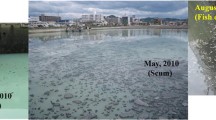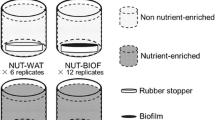Abstract
The response of the microbial community (in term of abundance and enzymatic activity) was investigated to test the effect of different bioremediation protocols to naturally enhance decomposition of organic polymers in harbour sediments (Genoa Harbour, Italy, N–W Mediterranean). Bioremediation techniques tested were bioaugmentation (5 different microorganisms’ inocula), biostimulation (air supply), and natural attenuation. The coupling bioaugmentation/biostimulation was also tested. After 60days, following the bioaugmentation protocol, bacterial densities correlated to the quantities of inocula amended to the boxes, suggesting that allochthonous community was able to survive and multiply. However, while bioaugmentation alone seems not to be able to carry out significative degradation, its coupling with air insufflations produced the best response: here bacterial densities increased, especially in the water (from 2.3×107 to 3.50×108cells ml−1), average cell size and enzymatic activities increased, and sedimentary organic matter was significantly depleted (PRT 5-folds reduction, CHO 1.5-folds reduction). The strong coupling observed between the sediment and water compartments together with the greatest microbial response observed in this latter suggest that the sediment–water interface may constitute a key compartment for the occurring of biodegradation processes in organic-rich sediments.
Similar content being viewed by others
References
M Alexander (1994) Inoculation M Alexander (Eds) Biodegradation and Bioremediation Academic Press California 226–247
C Arnosti BB Jørgensen J Sagemann T Tramdrup (1998) ArticleTitleTemperature dependence of microbial degradation of organic matter in marine sediment: polysaccharide hydrolysis, oxygen consumption, and sulphate reduction Mar. Ecol. Prog. Ser. 165 59–70 Occurrence Handle1:CAS:528:DyaK1cXjtlGqtLw%3D
RM Bertolotto F Ghioni M Frignani D Alvarado-Aguilar LG Bellucci C Cuneo MR Picca E Gollo (2003) ArticleTitlePolycyclic aromatic hydrocarbons in surficial coastal sediments of the Ligurian Sea Mar. Pollut. Bull. 46 IssueID7 907–913 Occurrence Handle1:CAS:528:DC%2BD3sXltVSks74%3D
AC Brown A McLachlan (1990) Ecology of Sandy Shores Elsevier Amsterdam
JH Carpenter (1965) ArticleTitleThe accuracy of the Wrinkler Method for dissolved oxygen analysis Limnol. Oceanogr. 10 191–197
RJ Chrost B Velimirov (1991) ArticleTitleMeasurement of enzyme kinetics in water samples: effect of freezing and soluble stabilizer Mar. Ecol. Prog. Ser. 70 93–100 Occurrence Handle1:CAS:528:DyaK38XnvV2mtA%3D%3D
R Danovaro M Fabiano (1995) ArticleTitleSeasonal and interannual variation of bacteria in a seagrass bed of the Mediterranean Sea: relationship with labile organic compounds and other environmental factors Aquat. Microbial Ecol. 9 17–26
R Danovaro D Marrale N Della Croce P Parodi M Fabiano (1999) ArticleTitleBiochemical composition of sedimentary organic matter and bacterial distribution in the Aegean Sea: trophic state and pelagic-benthic coupling J. Sea Res. 42 117–129 Occurrence Handle1:CAS:528:DyaK1MXls12msL4%3D
W Dejonghe N Boon D Seghers EM Top W Verstraete (2001) ArticleTitleBioaugmentation of soils by increasing microbial richness: missing links Environ. Microbiol. 3 IssueID10 649–657 Occurrence Handle1:STN:280:DC%2BD3Mnns12iuw%3D%3D
RP Dick (1994) Soil enzyme activities as indicators of soil quality Doran (Eds) et al. Defining Soil Quality for a Sustainable Environment Soil Sci. Soc. Am. Special Publication Madison, WI 102–124
M Dubois K Gilles JK Mamilton PA Rebers F Smith (1956) ArticleTitleColorimetric method for determination of sugars and related substances Anal. Chem. 28 350–356 Occurrence Handle1:CAS:528:DyaG28XjvFynsg%3D%3D
M Eschenhagen M Schuppler I Röske (2003) ArticleTitleMolecular characterization of the microbial community structure in two activated sludge systems for the advanced treatment of domestic effluents Water Res. 37 IssueID13 3224–3232 Occurrence Handle1:CAS:528:DC%2BD3sXktF2mtro%3D
M Fabiano R Danovaro S Fraschetti (1995) ArticleTitleA three-year time series of elemental and biochemical composition of organic matter in subtidal sandy sediment of the Ligurian Sea (NW Mediterranean) Cont. Shelf Res. 15 1453–1469
M Fabiano R Danovaro (1998) ArticleTitleEnzymatic activity, bacterial distribution, and organic matter composition in sediments of the Ross Sea (Antarctica) Appl. Environ. Microbiol. 64 3838–3845 Occurrence Handle1:CAS:528:DyaK1cXms1entLg%3D
M Fabiano D Marrale C Misic (2003) ArticleTitleBacteria and organic matter dynamics during a bioremediation treatment of organic-rich harbour sediments Mar. Pollut. Bull. 46 IssueID9 1164–1173 Occurrence Handle1:CAS:528:DC%2BD3sXmsVCgt70%3D
JC Fry (1990) Direct methods and biomass estimation. In: Grigorova R & Norris JR (Eds). Methods in Microbiology Academic Press London
I Gallizia (2000) Sperimentazione di metodologie di biodegradazione della materia organica in ambiente marino University of Genoa Italy
I Gallizia S McKlean IM Banat (2003) ArticleTitleBacterial degradation of Phenol and 2,4-Dichlorophenol J. Chem. Technol. Biotechnol. 78 959–963 Occurrence Handle1:CAS:528:DC%2BD3sXntV2rurw%3D
S Harayama Y Kasai A Hara (2004) ArticleTitleMicrobial communities in oil-contaminated seawater Curr. Opin. Biotechnol. 15 IssueID3 205–214 Occurrence Handle1:CAS:528:DC%2BD2cXkvV2gurs%3D
EF Hartree (1972) ArticleTitleDetermination of proteins: a modification of the Lowry method that give a linear photometric response Anal. Biochem. 48 422–427 Occurrence Handle1:CAS:528:DyaE38XksVGjur0%3D
JE Hobbie RJ Daley S Jasper (1977) ArticleTitleUse of Nucleopore filters for counting bacteria by fluorescence microscopy Appl. Environ. Microbiol. 33 1225–1228 Occurrence Handle1:STN:280:DyaE2s3itVertw%3D%3D
HG Hoppe (1991) Microbial extracellular enzyme activity: a new key parameter in aquatic ecology J. Chrost (Eds) Microbial enzymes in aquatic environments Springer-Verlag New York 60–79
AL Juhasz N Ravendra (2000) ArticleTitleBioremediation of high molecular weight polycyclic aromatic hydrocarbons: a review of the microbial degradation of benzo[a]pyrene Int. Biodeterior Biodegrad 45 IssueID(1–2) 57–88 Occurrence Handle1:CAS:528:DC%2BD3cXmsFaksbk%3D
F Lamy M Bianchi F Van Wambeke R Sempere V Talbot (1999) ArticleTitleUse of data assimilation techniques to analyze the significance of ectoproteolytic activity measurements performed with the model substrate MCA-Leu Mar. Ecol. Prog. Ser. 177 27–35 Occurrence Handle1:CAS:528:DC%2BD3cXht12htg%3D%3D
S Liu JM Sulfita (1993) ArticleTitleEcology and evolution of microbial populations for bioremediation Trends Biotechno 11 344–352 Occurrence Handle1:CAS:528:DyaK3sXms1Kjsrk%3D Occurrence Handle7764181
E Manini C Fiordelmondo C Gambi A Pusceddu R Danovaro (2003) ArticleTitleBenthic microbial loop functioning in coastal lagoons: a comparative approach Oceanologica Acta 26 27–38 Occurrence Handle1:CAS:528:DC%2BD3sXivFSisbs%3D
R Margesin A Zimmerbauer F Schinner (2000) ArticleTitleMonitoring of bioremediation by soil biological activities Chemosphere 40 339–346 Occurrence Handle1:CAS:528:DC%2BD3cXkt1Oktw%3D%3D
J Martinez F Azam (1993) ArticleTitlePeriplasmic aminopeptidase and alkaline phosphatase activities in a marine bacterium: implications for substrate processing in the sea Mar. Ecol. Prog. Ser. 92 89–97 Occurrence Handle1:CAS:528:DyaK3sXit12qs70%3D
J Martinez DC Smith DF Steward F Azam (1996) ArticleTitleVariability in ectohydrolytic enzyme activities of pelagic marine bacteria and its significance for substrate processing in the sea Aquat. Microbial Ecol. 10 223–230
LM Mayer LL Schick T Sawyer CJ Plante (1995) ArticleTitleBioavailable amino acids in sediments: a biomimetic, kinetic-based approach Limnol Oceanography 40 511–520 Occurrence Handle1:CAS:528:DyaK2MXotFGmsrY%3D
LA Meyer-Reil (1991) Ecological aspects of enzymatic activity in marine sediments RJ Chróst (Eds) Microbial Enzymes in Aquatic Environments Springer-Verlag New York 84–95
LA Meyer-Reil M Köster (2000) ArticleTitleEutrophication of marine waters: effects on benthic microbial communities Mar. Pollut. Bull. 41 IssueID(1–6) 255–263 Occurrence Handle1:CAS:528:DC%2BD3MXjtFOq
U Münster RJ Chróst (1990) Organic composition and microbial utilization of dissolved organic matter J Overbeck RJ Chróst (Eds) Aquatic Microbial Ecology Biochemical and Molecular Approaches. Springer-Verlag New York 8–46
ZJ Mudryk P Skórczewski (2004) ArticleTitleExtracellular enzyme activity at the air–water interface of an estuarine lake Estuar. Coast. Shelf Sci. 59 IssueID1 59–67 Occurrence Handle1:CAS:528:DC%2BD3sXpvVWls74%3D
TP Murphy A Lawson M Kumagai J Babin (1999) ArticleTitleReview of emerging issues in sediment treatment Aquat. Ecosyst. Health Manage 2 419–434 Occurrence Handle1:CAS:528:DC%2BD3cXjvF2rsA%3D%3D
R Palumbo JE Ferguson PH Rublee (1984) ArticleTitleSize of suspended bacterial cells and association of heterotrophic activity with size fractions of particles in estuarine and coastal waters Appl. Environ. Microbiol. 48 IssueID1 157–164
K Poremba (1995) ArticleTitleHydrolytic enzymatic activity in deep-sea sediments FEMS Microbiol. Ecol. 16 IssueID3 213–221 Occurrence Handle1:CAS:528:DyaK2MXktlCjtLY%3D
AM Romani A Butturini F Sabater S Sabater (1998) ArticleTitleHeterotrophic metabolism in forest stream sediment: surface versus subsurface zones Aquat. Microb. Ecol. 16 143–151
AM Romani (2000) ArticleTitleCharacterization of extracellular enzyme kinetics in two Mediterranean streams Arch. Hydrobiol. 148 99–117 Occurrence Handle1:CAS:528:DC%2BD3cXktVOgurg%3D
A Rusch M Huettel CE Reimers GL Taghon CM Fuller (2003) ArticleTitleActivity and distribution of bacterial populations in Middle Atlantic Bight shelf sands FEMS Microbiol Ecol. 44 IssueID1 89–100 Occurrence Handle1:CAS:528:DC%2BD3sXivFCrtLg%3D
M Unanue B Ayo M Agis D Slezak GJ Herndl J Iriberri (1999) ArticleTitleEctoenzymatic activity and uptake of monomers in marine bacterioplankton described by a biphasic kinetic model Microbial Ecol. 37 36–48 Occurrence Handle1:CAS:528:DyaK1MXhtVSlsLk%3D
M Valls Lorenzo V de (2002) ArticleTitleExploiting the genetic and biochemical capacities of bacteria for the remediation of heavy metal pollution FEMS Microbiol. Rev. 26 IssueID4 327–338 Occurrence Handle1:CAS:528:DC%2BD38Xot1ajt78%3D
PM Schie ParticleVan LY Young (2000) ArticleTitleBiodegradation of phenol: mechanisms and applications Biorem. J. 4 IssueID1 1–18
AD Venosa X Zhu (2003) ArticleTitleBiodegradation of crude oil contaminating marine shorelines and freshwater wetlands Spill Sci. Technol. Bull. 8 IssueID2 163–178 Occurrence Handle1:CAS:528:DC%2BD3sXkvFGmtbc%3D
GJ Verrhiest S Cortes B Clément B Montuelle (2002) ArticleTitleChemical and bacterial changes during laboratory conditioning of formulated and natural sediments Chemosphere 46 961–974 Occurrence Handle1:CAS:528:DC%2BD38XhtVKnsb0%3D
L Vezzulli D Marrale MP Moreno M Fabiano (2003) ArticleTitleSediment organic matter and meiofauna community response to long-term fish-farm impact in the Ligurian Sea (Western Mediterranean) Chem. Ecol. 19 IssueID6 431–440 Occurrence Handle1:CAS:528:DC%2BD3sXpvVKksLc%3D
L Vezzulli C Pruzzo M Fabiano (2004) ArticleTitleResponse of the bacterial community to in situ bioremediation of organic-rich sediments Mar. Pollut. Bull. 49 740–751 Occurrence Handle1:CAS:528:DC%2BD2cXpsVKjtr8%3D
K Watanabe (2001) ArticleTitleMicrorganisms relevant to bioremediation Curr Opin. Biotechnol. 12 237–241 Occurrence Handle1:CAS:528:DC%2BD3MXkt12lu78%3D
JT Westrich RA Berner (1984) ArticleTitleThe role of sedimentary organic matter in bacterial sulfate reduction: the G model tested Limnol. Oceanogr. 29 236–249 Occurrence Handle1:CAS:528:DyaL2cXkt1Ortbk%3D
PJ Williams (1973) ArticleTitleThe validity of the application of simple kinetic analysis to heterogeneous microbial populations Limnol. Oceanogr. 18 159–165 Occurrence Handle10.4319/lo.1973.18.1.0159
C Wittmann KP Suominen MS Salkinoja-Salonen (2000) ArticleTitleEvaluation of ecological disturbance and intrinsic bioremediation potential of pulp mill-contaminated lake sediment using key enzymes as probes Environ. Pollut. 107 IssueID2 255–261 Occurrence Handle1:CAS:528:DC%2BD3cXhslSnsr0%3D
A Wobus C Bleul S Maassen C Scheerer M Schuppler E Jacobs I Röske (2003) ArticleTitleMicrobial diversity and functional characterization of sediments from reservoirs of different trophic state FEMS Microbiol. Ecol. 46 IssueID3 331–347 Occurrence Handle1:CAS:528:DC%2BD3sXptlOqsrw%3D
V Yakovchenko LD Sikora DD Kaufman (1996) ArticleTitleA biologically based indicator of soil quality Biol. Fert. Soils 21 245–251
X Zhu AD Venosa MT Suidan K Lee (2001) Guidelines for the bioremediation of marine shorelines and freshwater wetlands. U.S. EPA Report Cincinnati, USA
Author information
Authors and Affiliations
Corresponding author
Rights and permissions
About this article
Cite this article
Gallizia, I., Vezzulli, L. & Fabiano, M. Evaluation of different bioremediation protocols to enhance decomposition of organic polymers in harbour sediments. Biodegradation 16, 569–579 (2005). https://doi.org/10.1007/s10532-004-0001-4
Accepted:
Issue Date:
DOI: https://doi.org/10.1007/s10532-004-0001-4




